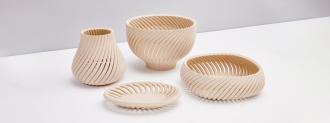Massachusetts startup Forust has developed a 3D printing technology that turns sawdust “ink” into wooden objects — which it claims are indistinguishable from those made from solid pieces of wood.
The challenge: Woodworking is typically a subtractive process. After a tree is stripped of its branches and bark, it’s cut into blocks and planks. Those are then cut or carved into desired shapes.
The scraps of wood and sawdust that are cut away from the wood can be turned into cheap pressed plywood, but they often end up in landfills. Additionally, the subtractive process places limits on the design of wooden objects.
3D printed wood: 3D printing is an additive process, with layers of ink — made of anything from plastic to dirt to living cells — precisely stacked into a three-dimensional shape.
Forust’s 3D printing technology works with an ink made of sawdust and lignin — a substance left over after wood is transformed into paper.
After it lays down one layer, it sprays it with a biodegradable binding agent before adding the next.
What’s new: People have been 3D printing objects with wood filaments (a mix of wood particles and plastic) since 2012, but they tend to look like they’re molded out of sawdust, rather than carved out of wood.
Forust claims its printer can accurately replicate wood grain, which would provide a much more natural look (though it doesn’t explain how the printer can do this).
“Our finished pieces are indistinguishable from traditionally manufactured wood products you would find in a store,” Forust CEO Andrew Jeffery boldly claims in a press release. “The additive manufacturing process literally becomes invisible.”
Why it matters: The Forust process takes two waste products and turns them into something useful. Not only does that keep the sawdust and lignin from ending up in landfills, it also eliminates the need to use new wood.
3D printing also opens up new design possibilities for wooden objects — just consider how hard it would be to create a hollow wooden sphere using traditional, subtractive woodworking techniques compared to making one using 3D printing.
“We want to make it easy for designers to explore complex new geometries for a wide variety of products and applications using an age-old material,” Jeffery said.
Our vision is a true circular manufacturing process.
Andrew Jeffery
The next steps: Forust is currently selling print-on-demand wooden home goods through its store, including a collection by Swiss designer Yves Béhar.
Alternatively, customers can submit their own designs for Forust to 3D print, with eight different color options in two finishes. They can also choose to have their design printed with the wood grain or without.
If customers don’t like their 3D printed wood designs — or get tired of them — they can just have the material turned into something else.
“At the end of the wood product’s life, we would like to see customers have two choices — dispose of it and it will biodegrade over time as any wood product would, or shred it and repurpose the material into future parts through Forust,” Jeffery said.
“Our vision is a true circular manufacturing process.”
We’d love to hear from you! If you have a comment about this article or if you have a tip for a future Freethink story, please email us at [email protected].






